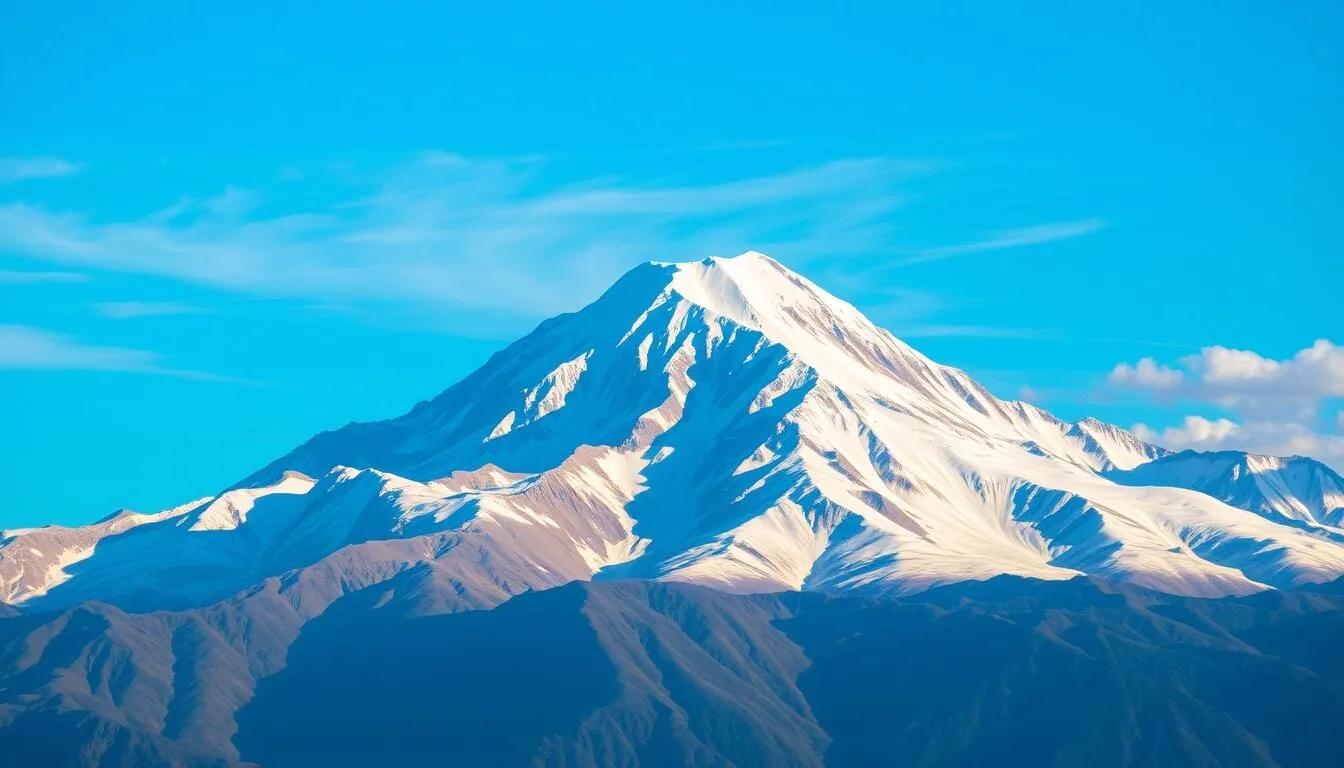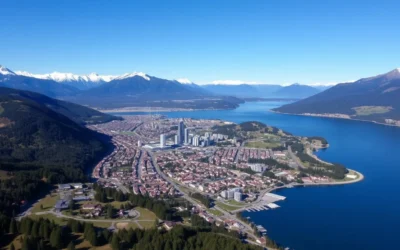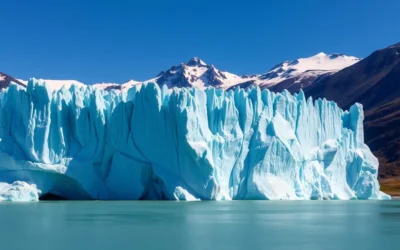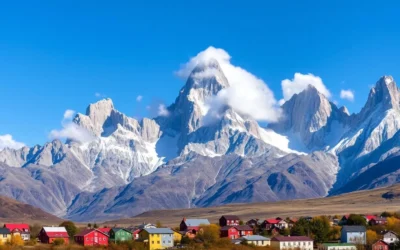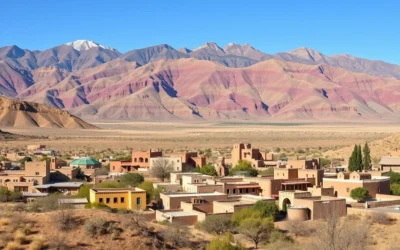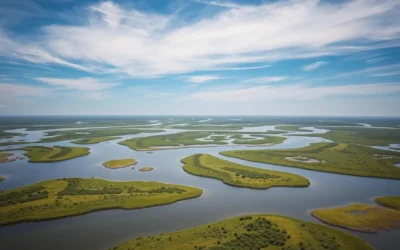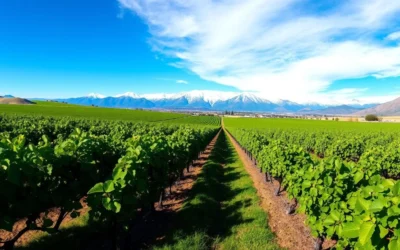✓ Accommodations✓ Flights✓ Rental Cars
Did you know that Aconcagua, standing proudly at 22,841 feet (6,962 meters), is not only the highest peak in the Western and Southern Hemispheres but also boasts a surprisingly low summit success rate of just 30-40%? Despite being considered a technically “easy” climb compared to Himalayan giants, this formidable “Sentinel of Stone” in Argentina’s Andes Mountains demands respect from even the most experienced mountaineers. Whether you’re an ambitious climber or a nature enthusiast seeking spectacular views, Aconcagua offers an unforgettable adventure in one of South America’s most breathtaking landscapes.
Overview of Aconcagua Mountain
Located in Argentina’s Mendoza Province near the Chilean border, Aconcagua is the crown jewel of the Andes mountain range. Part of the Seven Summits (the highest mountains on each continent), it attracts thousands of visitors annually. While serious mountaineers come to test their skills on its slopes, many travelers visit to experience the stunning national park surrounding the mountain, with its diverse ecosystems, wildlife, and trekking opportunities.
The mountain offers multiple routes of varying difficulty. The Normal Route (also called the Northwest Route) is the most accessible for non-technical climbers, while the Polish Glacier and Polish Traverse routes present more technical challenges. Even the “easier” routes require proper acclimatization, physical fitness, and preparation due to extreme weather conditions and high altitude.
Ready to Start Your Aconcagua Adventure?
Begin planning your journey to one of the world’s most magnificent mountains.
Getting to Aconcagua
The journey to Aconcagua begins with an international flight to Mendoza, Argentina (MDZ), the gateway city to the mountain. From major cities like Buenos Aires, Santiago (Chile), or São Paulo (Brazil), you can find connecting flights to Mendoza.
By Air
Mendoza’s Governor Francisco Gabrielli International Airport (MDZ) receives flights from major South American hubs. From the United States and Europe, you’ll typically connect through Buenos Aires or Santiago. The flight time from Buenos Aires to Mendoza is approximately 2 hours.
Once in Mendoza, you’ll need to arrange transportation to the starting point of your Aconcagua adventure, usually the small town of Penitentes or directly to Horcones, the entrance to Aconcagua Provincial Park.
Find the best flight deals to Mendoza for your Aconcagua adventure:
By Road
From Mendoza city, the journey to Aconcagua Provincial Park takes approximately 3-4 hours by car. The scenic drive follows Route 7 (also known as the International Route) through the Andes Mountains toward the Chilean border.
Many visitors opt to rent a car in Mendoza for flexibility, though guided transfers and public buses are also available. If you’re joining an organized expedition, transportation from Mendoza is typically included in your package.
Explore rental car options for your journey to Aconcagua:

Best Time to Visit Aconcagua
The official climbing season for Aconcagua runs from mid-November to early March, coinciding with the Southern Hemisphere’s summer. However, within this window, certain periods offer better conditions than others.
Early Season (November – December)
Advantages: Fewer crowds, pristine snow conditions
Challenges: Colder temperatures, potentially more snow to navigate
Best for: Experienced climbers who prefer solitude and don’t mind potentially challenging conditions
Peak Season (January – February)
Advantages: Most stable weather, warmest temperatures, maximum daylight
Challenges: Crowded routes, higher permit costs, advance reservations required
Best for: First-time Aconcagua climbers and those prioritizing the highest summit chances
Late Season (Late February – March)
Advantages: Fewer crowds, potentially stable weather
Challenges: Increasing risk of storms, “Viento Blanco” (white winds)
Best for: Experienced climbers looking for a balance between good conditions and fewer people
Weather Tip: Even during the summer season, Aconcagua’s weather can be extremely unpredictable. Temperatures at higher camps can drop to -20°C (-4°F) or lower, and the infamous “Viento Blanco” (white wind) can bring dangerous conditions with little warning. Always build flexibility into your itinerary to account for weather delays.

Permits and Regulations
Visiting Aconcagua requires proper permits, which vary depending on your planned activities. The Aconcagua Provincial Park administration strictly enforces these regulations to ensure visitor safety and environmental protection.
Climbing Permits
If you plan to climb Aconcagua or trek beyond the standard viewpoints, you’ll need an official climbing permit. These permits are season-specific and have different price tiers:
- High Season Permit (Dec 15 – Jan 31): Approximately $800-1,050 USD
- Shoulder Season Permit (Dec 1-14 and Feb 1-20): Approximately $600-800 USD
- Low Season Permit (Nov 15-30 and Feb 21-Mar 15): Approximately $400-600 USD
Permits can be obtained in Mendoza at the Provincial Park office or through authorized expedition companies. During peak season, permits may sell out, so advance planning is essential.
Trekking Permits
For those not attempting the summit but wanting to trek to viewpoints like Plaza Francia or Confluencia, a trekking permit is required. These are less expensive (approximately $40-80 USD) and can be purchased at the park entrance or in Mendoza.
Important: All visitors must register with park rangers upon entering Aconcagua Provincial Park. Medical insurance covering high-altitude evacuation is mandatory for climbing permit holders. Rangers may check your insurance documentation and required equipment before allowing entry.
Secure Your Aconcagua Experience
Join a guided expedition with experienced mountain guides who handle permit arrangements for you.
Book a Guided Tour
Where to Stay
Accommodations for an Aconcagua adventure fall into two distinct categories: city stays in Mendoza before and after your mountain experience, and mountain camps during your expedition.
Mendoza Accommodations
Mendoza offers a wide range of accommodations to suit every budget and preference. Most Aconcagua visitors stay in the city for at least a few days before and after their mountain adventure.
Luxury Options
Mendoza boasts several high-end hotels and wine resorts that offer perfect pre-expedition comfort or post-climb recovery.
Recommended: Park Hyatt Mendoza, Sheraton Mendoza Hotel, Cavas Wine Lodge
Price Range: $200-500+ USD per night
Mid-Range Options
Comfortable hotels and boutique accommodations that provide good amenities at reasonable prices.
Recommended: Hotel Nutibara, Diplomatic Hotel, Villaggio Hotel
Price Range: $80-200 USD per night
Budget Options
Hostels and budget hotels catering to climbers and backpackers with basic but clean facilities.
Recommended: Hostel Independencia, Hostel Empedrado, Mora International Hostel
Price Range: $15-80 USD per night
Find your perfect accommodation in Mendoza:
Mountain Accommodations
On Aconcagua itself, accommodations are limited to established camps along the climbing routes. These range from the relatively comfortable base camps to the more spartan high camps.

- Plaza de Mulas Base Camp (4,370m/14,340ft): The main base camp on the Normal Route features semi-permanent structures including dining domes, medical facilities, and ranger stations. Some expedition companies offer dome tents with cots.
- Plaza Argentina Base Camp (4,200m/13,780ft): The base camp for the Polish Traverse and Polish Glacier routes, slightly more remote than Plaza de Mulas but with similar facilities.
- High Camps: These include Camp Canada (5,050m), Nido de Cóndores (5,560m), and Camp Colera (5,970m) on the Normal Route. Accommodations are in mountain tents only, with increasingly basic conditions as you ascend.
Accommodation Tip: Most guided expeditions include all camping equipment. Independent climbers must bring their own high-quality, 4-season tents and sleeping systems rated for extreme conditions.
Climbing Routes and Difficulty
Aconcagua offers several established routes to the summit, varying in technical difficulty, scenery, and popularity. While often described as a “trekking peak,” all routes present significant challenges due to altitude, weather, and physical demands.

Normal Route (Northwest Route)
Difficulty: Least technical, but physically demanding
Duration: 18-21 days round trip
Starting Point: Horcones Valley
Base Camp: Plaza de Mulas (4,370m)
Highlights: Most popular route with established camps and facilities, good acclimatization profile
Challenges: Crowded during peak season, less scenic than other routes
Polish Traverse (Falso Polaco)
Difficulty: Moderate technical difficulty
Duration: 19-22 days round trip
Starting Point: Vacas Valley
Base Camp: Plaza Argentina (4,200m)
Highlights: More scenic approach, less crowded, “360” option to descend via Normal Route
Challenges: More exposed to weather, requires some basic snow/ice skills
Polish Glacier Direct
Difficulty: Most technical, requires mountaineering experience
Duration: 20-23 days round trip
Starting Point: Vacas Valley
Base Camp: Plaza Argentina (4,200m)
Highlights: True mountaineering challenge, spectacular glacier climbing
Challenges: Requires technical ice climbing skills, higher risk, weather dependent
“Standing in the heart of the Andes, wedged between Chile and Argentina, Aconcagua’s lofty heights make it the ideal introduction to high altitude mountaineering.”
Ready for the Summit Challenge?
Join experienced guides for your Aconcagua expedition with comprehensive support.
Trekking Options for Non-Climbers
Not everyone visiting Aconcagua aims to reach the summit. The park offers excellent trekking opportunities for those who want to experience the mountain’s majesty without the technical challenges of a summit attempt.

Popular Treks
Confluencia Trek (3 Days)
Distance: 16km round trip
Max Altitude: 3,400m (11,150ft)
Difficulty: Easy to Moderate
Highlights: Perfect introduction to Aconcagua, beautiful valley views, acclimatization opportunity
This short trek takes you from Horcones to Confluencia Camp, offering spectacular views of Aconcagua’s south face. It’s ideal for those with limited time or as an acclimatization trek before longer hikes.
Plaza Francia Trek (3-4 Days)
Distance: 25km round trip
Max Altitude: 4,200m (13,780ft)
Difficulty: Moderate
Highlights: Spectacular view of Aconcagua’s imposing south face, diverse landscapes
This trek extends beyond Confluencia to Plaza Francia, offering the most impressive view of Aconcagua’s 3,000m south wall. The trek can be done as a day hike from Confluencia or with camping.
Plaza de Mulas Trek (7 Days)
Distance: 40km round trip
Max Altitude: 4,370m (14,340ft)
Difficulty: Moderate to Challenging
Highlights: Experience the main Aconcagua base camp, mountain culture, stunning panoramas
This longer trek takes you all the way to the main base camp on the Normal Route. You’ll experience the bustling atmosphere of climbers preparing for summit attempts and enjoy magnificent mountain views.
Experience Aconcagua Without Summit Climbing
Book a guided trekking experience to the spectacular viewpoints of Aconcagua.
Book a Trekking Tour
Trekking Tip: Even the “easy” treks around Aconcagua reach significant altitudes. Proper acclimatization, hydration, and preparation are essential. Consider spending 2-3 days in Mendoza (760m) before starting your trek to begin the acclimatization process.
Preparing for Aconcagua
Whether you’re planning a summit attempt or a trek to one of the viewpoints, proper preparation is crucial for a safe and enjoyable Aconcagua experience.
Physical Preparation
Aconcagua demands excellent physical conditioning, particularly for summit attempts. Begin training at least 4-6 months before your trip with a focus on:
- Cardiovascular Endurance: Regular hiking, running, cycling, or swimming sessions (3-5 times weekly)
- Strength Training: Focus on leg and core strength for carrying heavy packs uphill
- Load Training: Practice hiking with a weighted pack (gradually building to 40-50 pounds)
- Altitude Exposure: If possible, train at higher elevations or plan a pre-trip to moderate altitudes

Essential Equipment
Aconcagua requires specialized equipment, particularly for summit attempts. Here’s a basic overview of what you’ll need:
Technical Gear (Summit Climbers)
- Mountaineering boots (double or triple boots)
- Crampons
- Ice axe
- Trekking poles
- Climbing helmet
- Harness (for some routes)
- 4-season expedition tent
- Extreme weather sleeping bag (-20°F/-30°C rating)
Clothing
- Base layers (synthetic or merino wool)
- Mid-layers (fleece or softshell)
- Insulated jacket (down or synthetic)
- Waterproof/windproof outer shell
- Insulated pants
- Expedition-weight gloves/mittens
- Warm hat and sun hat
- Glacier sunglasses and goggles
- Gaiters
Other Essentials
- Expedition backpack (70-90L)
- Day pack (30-40L)
- Headlamp with extra batteries
- Water bottles (insulated) and water treatment
- High-altitude sun protection
- First aid kit with altitude medications
- Personal hygiene items
- Camera with extra batteries
Equipment Tip: Many expedition companies offer equipment rental in Mendoza, which can save you the hassle of traveling with bulky gear. However, always break in your mountaineering boots before arriving.
Altitude Considerations
Altitude sickness is the primary reason climbers fail on Aconcagua. Proper acclimatization is essential:
- Spend 2-3 days in Mendoza (760m) before starting your trek
- Follow the “climb high, sleep low” principle during your ascent
- Stay well-hydrated (4-5 liters daily)
- Consider preventative medications like Acetazolamide (Diamox) after consulting with a travel physician
- Recognize symptoms of altitude sickness and be prepared to descend if necessary
Medical Warning: Symptoms of severe altitude sickness require immediate descent. These include severe headache, vomiting, confusion, difficulty breathing at rest, or inability to walk in a straight line. Never ignore these symptoms or try to “push through” them.
Guided vs. Independent Expeditions
Visitors to Aconcagua must decide whether to join a guided expedition or attempt the mountain independently. Each approach has distinct advantages and considerations.
Guided Expeditions
- Expert Leadership: Professional guides with extensive Aconcagua experience
- Logistics Handled: Permits, transportation, food, and equipment coordination
- Safety Support: Medical training, emergency equipment, and evacuation protocols
- Higher Success Rates: Structured acclimatization and experienced decision-making
- Educational Opportunity: Learn mountaineering skills from professionals
- Group Experience: Built-in camaraderie and shared challenge
Independent Expeditions
- Lower Cost: Significant savings compared to guided options
- Flexibility: Set your own pace and schedule
- Greater Challenge: Test your mountaineering skills and self-reliance
- Smaller Groups: Travel with just your chosen partners
- Personal Achievement: Complete satisfaction of self-guided success
- Learning Experience: Develop expedition planning and management skills
Important Consideration: Independent expeditions should only be attempted by those with significant prior mountaineering experience, including high-altitude climbs, technical skills appropriate to your chosen route, and wilderness first aid knowledge. Even experienced mountaineers often choose guided expeditions for their first Aconcagua attempt.

Recommended Guide Services
If you choose a guided expedition, several reputable companies offer Aconcagua climbs with varying levels of service and support:
Full-Service Expeditions
These provide comprehensive support including porters for personal equipment, higher guide-to-client ratios, and more comfortable base camp facilities.
Recommended Companies:
- Alpenglow Expeditions
- Adventure Consultants
- Mountain Trip
Price Range: $5,500-8,500 USD
Standard Guided Expeditions
These offer professional guiding and logistical support with some personal equipment carrying required.
Recommended Companies:
- Aconcagua Mountain Guides
- Kandoo Adventures
- Rainier Mountaineering Inc. (RMI)
Price Range: $4,000-6,000 USD
Local Argentine Operators
These often provide more basic services at lower prices, though quality and English proficiency can vary.
Recommended Companies:
- Grajales Expeditions
- Aymara Adventures
- Inka Expediciones
Price Range: $2,500-4,500 USD
Find Your Perfect Aconcagua Guide
Explore guided expedition options with experienced mountain professionals.
Beyond Climbing: Other Activities Around Aconcagua
The Aconcagua region offers much more than just mountain climbing. The surrounding areas provide numerous opportunities for adventure, relaxation, and cultural experiences.

Mendoza Wine Country
Mendoza is world-renowned for its Malbec wines and beautiful vineyards set against the Andes backdrop. Many climbers incorporate wine tours before or after their Aconcagua adventure.
- Wine Tours: Visit multiple wineries (bodegas) with guided tastings
- Biking Wine Routes: Rent bicycles to explore the Maipu or Lujan de Cuyo wine regions
- Wine Pairing Dinners: Experience Argentine cuisine with perfectly matched local wines
- Harvest Festivals: If visiting in February-March, experience the vendimia celebrations
Explore Mendoza’s world-class wineries and vineyards:
Book a Wine Tour
Hot Springs and Thermal Baths
The Andes region features several natural hot springs, perfect for relaxing tired muscles after mountain exertion.
- Cacheuta Thermal Spa: Located about 38km from Mendoza, offering multiple pools and spa services
- Termas de Puente del Inca: Historic thermal baths near the colorful natural bridge formation (currently closed for preservation, but the site can be visited)
- Termas de Cacheuta: Family-friendly thermal water park with various pools and water features
Additional Outdoor Activities
Whitewater Rafting
The Mendoza River offers exciting rafting opportunities with rapids ranging from Class II to IV, depending on the season. Half-day and full-day trips are available from Potrerillos, about an hour from Mendoza city.
Horseback Riding
Experience the Andes like a traditional Argentine gaucho on horseback riding excursions. Options range from short rides to multi-day adventures through mountain valleys and along historic trails.
Mountain Biking
The foothills of the Andes offer excellent mountain biking terrain. Guided tours and bike rentals are available for routes of varying difficulty, from gentle paths to technical descents.

Practical Tips for Aconcagua Visitors
These essential tips will help you have a safer, more enjoyable experience when visiting Aconcagua and the surrounding region.
Health and Safety
- Travel Insurance: Purchase comprehensive travel insurance that specifically covers high-altitude mountaineering and evacuation (required for permits)
- Vaccinations: Ensure routine vaccinations are up-to-date; hepatitis A and typhoid are recommended
- Medical Check: Get a thorough medical examination before attempting high-altitude activities
- First Aid Knowledge: Basic wilderness first aid skills are invaluable in remote areas
- Emergency Contacts: Keep important phone numbers accessible, including your country’s embassy in Argentina
Money and Documents
- Currency: Argentine Peso (ARS) is the local currency; bring some US dollars as backup
- ATMs: Available in Mendoza but not in mountain areas; withdraw sufficient cash before departing
- Credit Cards: Widely accepted in Mendoza but may incur foreign transaction fees
- Passport: Must be valid for at least six months beyond your planned departure date
- Permits: Keep copies of your climbing or trekking permits with you at all times
Communication
- Cell Service: Available in Mendoza but limited to non-existent on the mountain
- Wi-Fi: Common in Mendoza accommodations; sometimes available at base camps
- Satellite Devices: Consider renting a satellite phone or bringing a GPS messenger for emergency communication
- Language: Spanish is the official language; basic Spanish phrases are helpful
- Time Updates: Arrange for someone to track your progress and expected check-in times

Local Etiquette Tip: Argentines typically greet with a kiss on the cheek, even in business settings. Dinner is eaten late by North American standards, often starting at 9 PM or later. Tipping 10% is customary in restaurants.
Packing Tips
- Weight Limits: If using mules for base camp transport, gear must typically be divided into 20kg (44lb) loads
- Batteries: Cold temperatures drain batteries quickly; keep spares in inside pockets
- Plastic Bags: Bring extra ziplock and garbage bags for waterproofing and waste management
- Snacks: Pack favorite energy foods from home as options are limited on the mountain
- Medications: Bring all necessary prescriptions plus altitude medications as recommended by your doctor
Environmental Responsibility: Aconcagua faces increasing environmental pressure from visitors. Pack out ALL waste (including human waste above base camps using WAG bags), stay on established trails, and follow Leave No Trace principles. The park enforces strict regulations with significant fines for violations.
Ready for Your Aconcagua Adventure?
Standing at the roof of the Americas, Aconcagua offers an unparalleled adventure for mountaineers, trekkers, and nature enthusiasts alike. Whether you’re challenging yourself to reach its lofty summit or simply exploring its magnificent surroundings, this Argentine giant promises unforgettable experiences and breathtaking vistas. With proper preparation, respect for the mountain’s challenges, and an adventurous spirit, your journey to Aconcagua will surely rank among your most treasured travel memories. The Sentinel of Stone awaits your visit – are you ready to answer its call?
Begin Your Aconcagua Journey Today
Start planning your adventure to one of the world’s most magnificent mountains.

The above is subject to change.
Check back often to TRAVEL.COM for the latest travel tips and deals.
